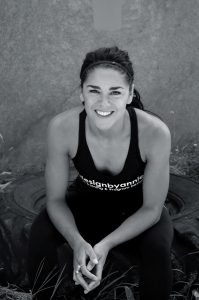As a former powerlifter, I can’t imagine life without bilateral movements like the barbell squat and deadlift, and sure enough, every one of my female clients can squat and hinge like a boss at some point. But recently I’ve taken a page out of Mike Boyle’s playbook, downplayed the role of these big lifts in my female athletes’ programs, and have placed a greater emphasis on their unilateral counterparts…with a few tweaks.
The Devil Is In the Details
Single-leg training is a seemingly boring topic as far as lifting is concerned, but from an injury-prevention, strength and performance standpoint, it goes a long way into making us into stronger, unf*ckable-with human beings.
Women in particular can benefit a lot from single-leg work, and for some, it’s likely better than their bilateral cousins. Why?
Because there are certain things about being a woman that just makes things a wee bit different, starting with our anatomy, hormones, lifestyle, even what we tend to wear on a day to day basis (More on that here). Think: Ballet flats with no arch support, high heels that screw up our posture in every single way, and don’t even get me started on the evils of a large, leather tote bag that carries everything from our laptops to our gym clothes to our lunch while lugging a toddler on our hip.
It’s hard being a woman, okay?!
It seems a tad melodramatic but these are real-life scenarios that I’m thinking about when I’m programming for my female clients. While bilateral movements are still on the menu, single-leg exercises have less room for injury than say, a barbell squat might, and way more flexibility in its execution.
For example, a walking lunge can be progressed many ways to make the exercise more challenging, but given that most of my female clients are already quad dominant, I will program other variations like the reverse lunge from a deficit, a walking lunge with a slight forward lean, or a front loaded kettlebell lunge for more core work.
That’s three versions of the same single-leg exercise that emphasizes different things: greater ROM, more posterior chain/booty gains, and heavy core stability, respectively. As you can see, it’s the smallest tweaks that can deliver the biggest impact, and I didn’t even have to load them up with a barbell!
Single-leg training can therefore be among your “big bang for your buck” exercises if you consider the nuances that work best for you as a woman, or for one of your female clients.
But don’t just take my word for it. I recently asked some of the top strength coaches in the game how they approach single-leg training with their female clients/athletes. Heres’ what they had to say.
How The Pros Do It

Steph Gaudreau, Stupid Easy Paleo
Unilateral training is something I studiously ignored for a good chunk of my training years, much to my own regret later on. Lots of time spent training in the frontal plane with bilateral movements like squats, deadlifts, cleans, and snatches meant I was able to compensate for some pretty subpar movement patterns and imbalances. Pretty much the only time I was training a different pattern was in the split jerk, and even then, it was just the lower body. I notice the same in most of the weightlifters I coach. After ongoing issues with my QL, I sought out ways to incorporate more movement outside the frontal plane…and encourage my lifters and the general population that I coach to do the same. Enter unilateral exercises!
One thing I notice and try to emphasize is the difference between slow and quick movements. It’s sometimes easier for lifters to mask side-to-side imbalances with, say, lunges performed at normal speed. Making them slow it down, or better yet, perform true single-leg movements (like single leg deadlifts) can reveal a lot about where momentum is normally covering up issues with balance and stability. Another variation I like to incorporate is a quick change of direction followed by a static hold / balance. One example is stepping out into a forward lunge, then on the return to midline, holding the knee up in a single leg balance. Mix it up with lateral and rear movements for a great addition to your dynamic warm-up.
For more strength training knowledge bombs from Steph, check out her newest program Made Strong and her Basic Barbell Program

Tony Gentilcore, TonyGentilcore.com
One tweak I make with single leg training, but especially with female clients is how they situate their torso during the exercise. Take for example a reverse lunge. Seems self-explanatory enough: you grab a pair of DBs, hold them at your sides, and then step back making sure to maintain an upright torso throughout the duration of the set.
A cue I prefer to use is instead of thinking “shoulders over hips” (upright torso) you should think about “keeping your shoulders over your knees” (a little more of a forward lean).
WHY?
Because I said so.
But mostly because women tend to have a little more anterior pelvic tilt compared to their Y chromosome carrying counterparts. Compound that with women’s proclivity to wear high-heeled shoes more frequently, this can (not always) place a little more undue stress on the lumbar spine. A simple fix is to “nudge” more posterior pelvic tilt into their program or cue them in a way where they’re not just cranking through their lower back on everything.
 Annie Miller, FitDesignByAnnie
Annie Miller, FitDesignByAnnie
Single leg exercises are great for building strength, but they are highly effective for metabolic training as well. When you work one leg at time you spend double the total time under tension, causing your body to work for twice the amount of time, resulting in double the metabolic effect on your body (you’ll be breathing really freaking hard + burning all the calories). Yay single leg work for cardio!
Possibly the best single leg exercise I use with my clients and myself is the back foot elevated split squat, better known as the Bulgarian split squat. This exercise challenges balance, front foot interaction with the floor and is HIGHLY effective in building overall strength that translates to the main lifts of squats and deadlifts. You can also load it several different ways (i.e two dumbbells, one dumbbell, back rack barbell, front rack barbell), causing different stimulus to the muscles. I steer away from this exercise if a client has excessively tight quads or if they have a history of knee pain as the back leg position can cause discomfort and there are plenty of other single leg exercises to choose from.
My other most used single leg exercise is the reverse lunge from a deficit:
I use this most often to increase the range of motion in the working hip (getting that hip crease well below the knee) while keeping a neutral upright spine. This is especially useful for clients who struggle or have limitations getting below parallel during back squats, or even goblet squats.
For a glute dominant hinging exercise (opposed to a knee dominant exercise), the bench single leg glute bridge (upper back on a bench) is the easiest for people to execute properly.
It’s a great way to hit the glutes with very little room for error and positive carryover to other hinging exercises. The single leg RDL is another favorite of mine BUT is often performed with poor form. If a person can hinge at the hips properly, these are a highly effective exercises for strengthening the core and posterior chain.
Side note: I wrote all about how to master the hip hinge without your back exploding HERE.
 Michael Anderson, Anderson Strength and Fitness
Michael Anderson, Anderson Strength and Fitness
The vast majority of my female clients perform single-leg exercises for a variety of reasons. The pistol squat off of a box is without a doubt my favorite single leg squat variation. All of my female high school track athletes perform this exercise as it allows them to develop a huge amount of single leg stability, especially around the knee and hip joints. When I give this to my adult female clients we often start with a supported variation or eccentric only.
The shoulders and feet elevated single leg hip thrust is one of the more dreaded single leg exercises I give anyone. It works your hamstrings on both ends and creates a deep glute burn. I love it because it’s a “bang for your buck” exercise where you can get a huge training effect with minimal external loading.
My track athletes know that if you want to go fast you need a strong posterior chain and my adult clients all like having something to hold up their pants!
Here’s the deal….
Single-leg training is smart. Like, really, really smart. And that goes if you’re an Olympic weightlifter, a track athlete, or a badass attorney by day who loves to lift by night. Not only will adding more unilateral training spice up your workouts, it’ll help do things like clean up your technique, correct muscular imbalances, unmask instability issues so you can fix them fast, and it may even make some exercises, including bilateral ones, more comfortable to execute down the road.
Pay attention to the nuances in your lifts and don’t be afraid to toy around with the minor details in a movement to see what works best for you.
Did you love this post? Share it out with the homies and download one of my freebies 6 Weeks to Strong, Sexy Glutes & The Warm-up Guide when you sign up for my email list!


Comments 5
Pingback: Stuff To Read While You’re Pretending To Work: 2/9/17 | Fitness & Yoga
Pingback: Stuff To Read While You're Pretending To Work: 2/9/18 - Tony Gentilcore
Pingback: Stuff To Read While You’re Pretending To Work: 2/9/18 | Fitness & Yoga
Pingback: Stuff To Read While You’re Pretending To Work: 2/9/18 | Don Kellough
Pingback: Barbell Training 101: What You Need To Know Before You Start - Barbell Pilates with Trish DaCosta